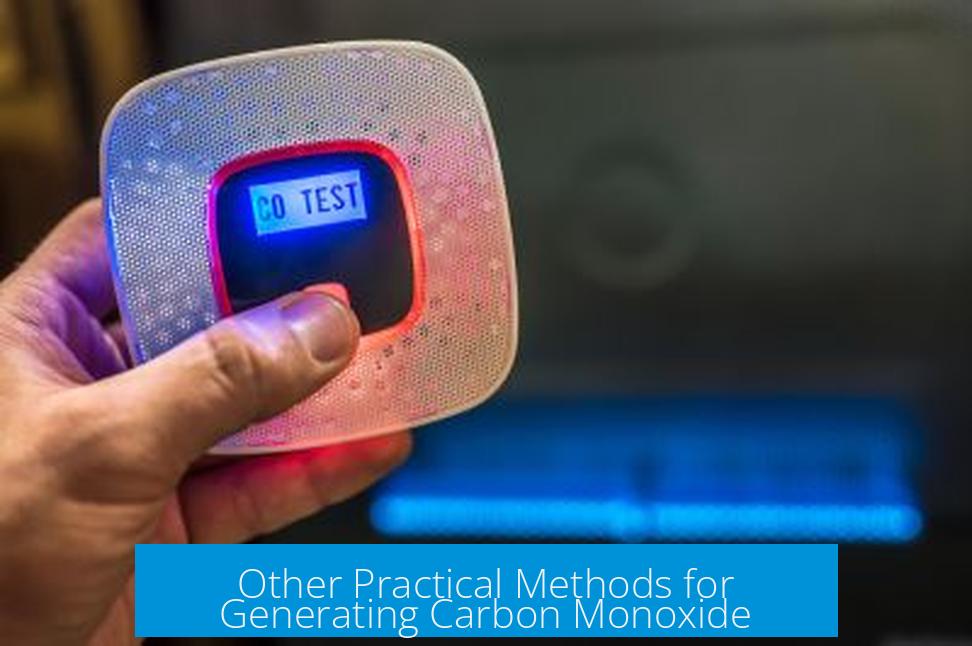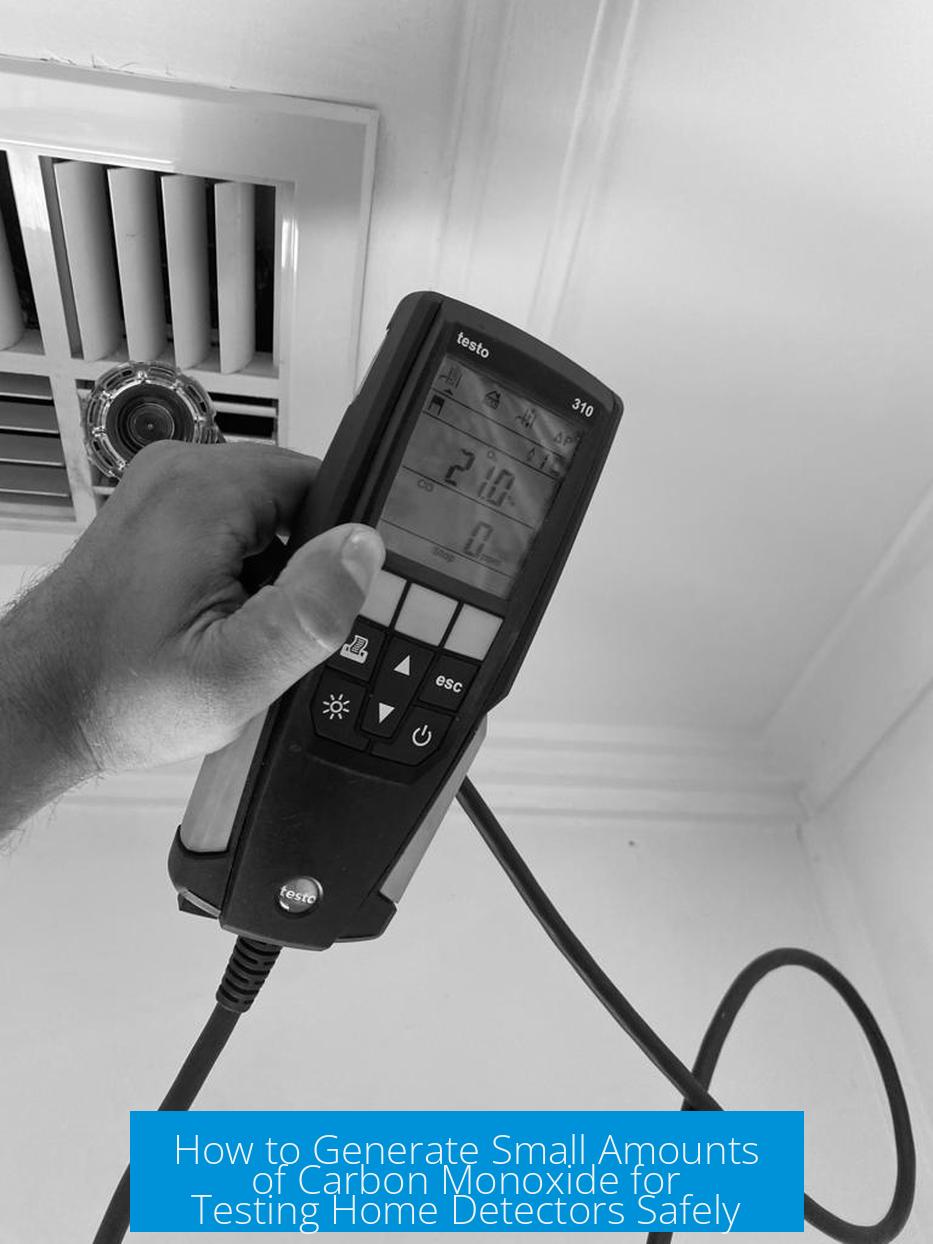How to Generate Small Amounts of Carbon Monoxide for Testing Household Detectors

Generating small, controlled amounts of carbon monoxide (CO) to test household detectors can be done safely by alternative methods. One practical approach is to use hydrogen gas as a proxy because many domestic CO detectors also respond to hydrogen. For actual CO generation, chemical methods with formic acid and sulfuric acid under controlled conditions work best without excessive risk.
Using Hydrogen Gas as a Safe Alternative
Many household carbon monoxide detectors detect hydrogen along with CO. This allows users to test the detector’s basic functionality using hydrogen, which is easier and safer to produce. When hydrogen is introduced near the sensor, a response usually indicates the detector is operational.
- Hydrogen is less toxic than CO, so inhaling small amounts poses less risk. However, hydrogen remains flammable and should be handled carefully.
- If a detector detects hydrogen, it very likely detects CO as well, since CO detection is typically simpler for such sensors.
- This method is not suitable for industrial or laboratory CO sensors specially designed to ignore hydrogen.
For testing domestic detectors, this hydrogen method offers a quick diagnostic test for detector function but does not replace sensitivity testing.
Limitations of Hydrogen Testing and Sensitivity Concerns
While hydrogen testing confirms if a detector works at all, it does not quantify sensitivity. CO detectors degrade over time and may stop responding at low CO concentrations but still trigger at dangerous high levels.
Since detector sensitivity can diminish, regular replacement—approximately every 5 to 7 years—is recommended. A detector that passes hydrogen testing might still provide inadequate warning if its sensitivity fades.
Chemical Generation of Carbon Monoxide
For controlled CO generation, a laboratory method involving formic acid and concentrated sulfuric acid is effective.
- Add a few drops of formic acid into a vial containing about 5 mL of concentrated sulfuric acid.
- Gently warm the mixture on a hotplate to produce carbon monoxide gas via the chemical reaction.
- Use this small volume of CO to test the detector’s response carefully.
This method produces small amounts of CO and minimizes risk when handled correctly. However, avoid inhaling the gas directly. This setup offers more precise and relevant testing compared to the hydrogen method.
Other Practical Methods for Generating Carbon Monoxide

Besides chemical production, some practical methods can generate CO in small quantities, but each comes with safety concerns:
- Vehicle Exhaust: Holding the CO detector near a running vehicle’s exhaust can generate CO, but risks toxicity and exposure to pollutants.
- Burning Charcoal or Coal with Limited Oxygen: Produces CO due to incomplete combustion. Requires careful control of oxygen levels and ventilation.
- Graphite Rod with Water Addition: Passing a large electric current through a graphite rod until it glows and then adding water can produce CO via the Water-Gas Shift Reaction (WGSR).
- Burning Plastics or Smoke: Combustion of certain plastics or cigarette smoke contains CO, detectable by many household sensors.
- Matches or Cigarette Smoke: Blowing smoke or igniting matches near the sensor will usually trigger it, confirming it detects combustion-related gases.
These methods may not be precise and involve variable CO concentrations. They also present inhalation risks and should be approached with caution, appropriate ventilation, and safety measures.
Summary of Key Takeaways
- Hydrogen gas offers a safer, simpler way to check if a household CO detector functions.
- Hydrogen testing does not validate detector sensitivity or accuracy over time.
- Chemical generation using formic acid and sulfuric acid provides controlled, small amounts of CO for testing.
- Other CO sources include vehicle exhaust, controlled combustion, and smoke but carry safety risks.
- Regular replacement of CO detectors ensures reliable performance and safety.
How can I test my household CO detector without using carbon monoxide directly?
Many CO detectors also detect hydrogen. You can generate small amounts of hydrogen more safely to check if your detector responds. This method works well for most domestic CO detectors but not for industrial types.
What is a simple method to create actual carbon monoxide for testing?
Mix a few drops of formic acid with 5mL of concentrated sulfuric acid in a vial, then gently warm it. This reaction produces a small, controlled amount of CO suitable for testing detectors.
Are there any other practical ways to generate carbon monoxide for detector testing?
Vehicle exhaust, burning charcoal in low oxygen, or cigarette smoke can produce CO. However, these methods can be unsafe or uncontrolled and should be used cautiously.
Can hydrogen testing measure my CO detector’s sensitivity accurately?
No. Hydrogen testing only shows if the detector responds, not how sensitive it is. Detectors can lose sensitivity over time. For accurate sensitivity, consider replacing old detectors regularly.
Is it safe to generate and inhale carbon monoxide for testing purposes?
Generating small amounts for testing is possible, but inhaling CO is dangerous. Always avoid deliberate inhalation. Use indirect methods like hydrogen testing when possible for safety.





Leave a Comment